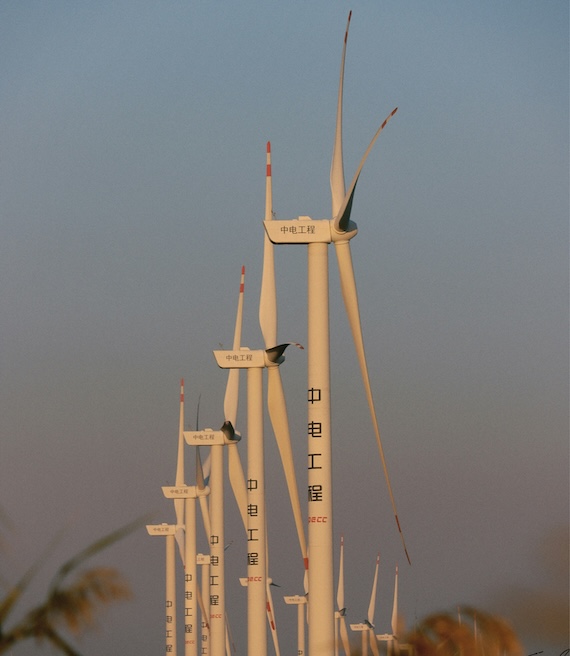Ann Arbor (Informed Comment) – The dufus-in-chief perorated on Friday once again on wind power, complaining that the components are made in China but that “I have never seen a wind farm in China. Why is that? Somebody check that out.” His just-passed tax bill eliminates federal incentives for the industry, ensuring a vast slow-down in its build-out in this country.
Back in the real world, China will have 520 gigawatts of nameplate wind power by the end of this year, more than any other country in the world. China has half the world’s installed wind capacity. Since most contemporary turbines generate 2 to 3 megawatts, that would translate into roughly 190,000 wind turbines. Trump has never seen one because he hasn’t bothered looking, or he has a weird fixation on wind turbines, or because he is telling another of his tens of thousands of lies, or because some fossil fuel billionaire slipped him a fiver to humiliate himself, and the country, this way.
Wind power generates about 13% of China’s electricity in 2025.
The Jiuquan Wind Power Base in Gansu Province is a whole complex of wind farms, with a generation capacity of 10 gigawatts and with plans to expand to 20 gigawatts, at which point it will have 7,000 wind turbines. Twenty gigawatts would provide electricity to 6 million American-style households, or all of Illinois and then some.
China is rapidly becoming expert in combining wind power with large scale battery storage, so that power captured when winds are high can be released when they die down, smoothing out the grid. Over time this technology will allow the actual capacity of wind farms to approach the nameplate capacity.
This wind power capacity allows China to avoid Liquid Natural Gas (LNG) imports for energy generation to the tune of roughly $80 billion a year. In contrast, once the turbines are installed, the fuel (wind) is free.
These savings do not even take into account the reduction in harm to the environment that comes from burning fossil fuels and spewing billions of tons of carbon dioxide into the atmosphere annually, the equivalent of hundreds of thousands of atomic bombs going off daily, heating up the earth and threatening climate breakdown. (You won’t like climate breakdown.)
The economic and trade implications of this incredible rise of a new industry cannot be overestimated. Consider what Energy magazine reported just last year of the German firm Luxcara. It chose MingYang Smart Energy to produce 16 enormous wind turbines, to be installed by 2028, for a project that will supply 400,000 homes with electricity. This is Germany, where MingYang had to win out against Siemens Gamesa and Orsted.
The World Economic Forum points out that “the value of China’s clean technology exports is set to exceed $340 billion in 2035, based on current policy settings.” That is a market Trump has prevented the US from competing in.
When a country specializes in a technology, it achieves breakthroughs and efficiencies that make it an attractive source for imports of the technology by other countries. China already makes 80% of the world’s solar panels. It could end up being the major manufacturer of its wind turbines, too. If the United States isn’t in this game, it can’t compete for a share of those profits. Losing out is what the economists call an opportunity cost.
In contrast, the United States is only expected to have 160 gigawatts of wind by the end of this year, less than a third of what China has. As noted, Trump’s smelly ugly tax bill removes incentives from renewables and bestows extra government subsidies on fossil fuels, which will greatly slow wind power growth over the next three years at least.
The US wind turbine manufacturing sector is led by companies like GE Vernova, Vestas and Siemens Gamesa, which can, all together, assemble 15 gigawatts of wind power each year. The top five US wind manufacturers bring in over $70 billion a year. Over 130,000 US workers are employed in this industry. Trump is trying to kneecap the sector, costing the US tens of thousands of jobs and, you guessed it, incurring massive opportunity costs.
The onshore turbines installed in the US have 58% US-made content. We are behind on offshore turbines, which are only 42% US-made, since the nacelles and blades are imported. The Republican attack on this industry will simply take those numbers down and leave the industry to China and Europe.
China’s wind, solar, water and battery development has been so extensive and so rapid that its emissions are possibly declining this year despite its still heavy dependence on coal (a sector, however, that is rapidly shrinking).

Photo of Haiyan, Jiaxing, China, in 2024 by Danie LIU on Unsplash
There are other benefits. By 2050, Chinese offshore wind alone (a small part of the total) will prevent 165,000 premature deaths that would otherwise have been caused by the particulate matter burning fossil fuels puts into the air, causing lung cancer and other diseases.
If this misstatement of the facts were just another Trumpism, with no more impact than the farts he let rip when in court on trial for rape, it would be merely puzzling and bizarre. These sorts of stubborn fantasies, however, have turned into national American policy, guaranteeing the steep decline of the United States in the coming century.


 © 2026 All Rights Reserved
© 2026 All Rights Reserved